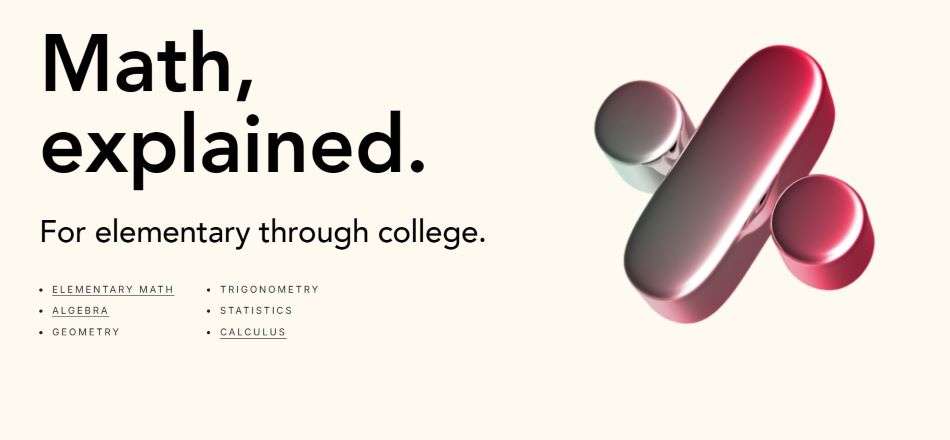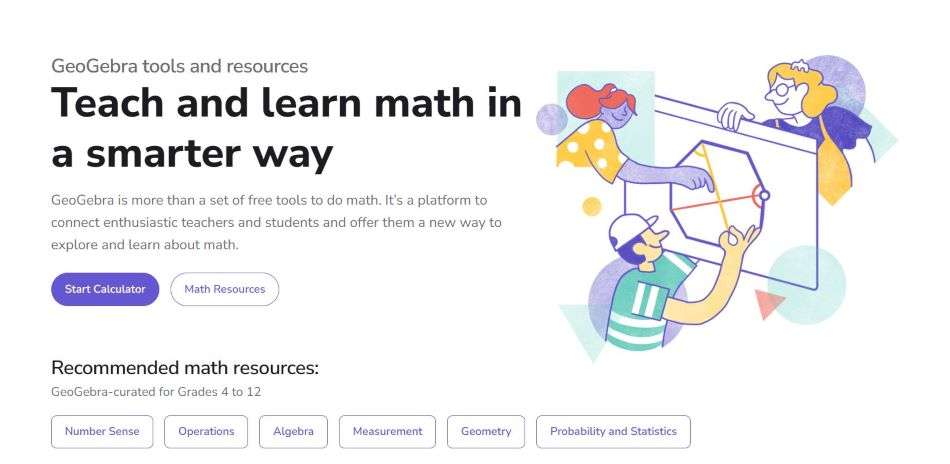A deep dive on the Top AI tools for learning math in 2025

Math plays a crucial role in nearly every aspect of daily life, whether it’s sorting objects by color, checking the time, or following a recipe. While professionals rely on math for their careers, its importance extends to everyone, making it essential to learn and continuously improve these skills as part of everyday life. So we will explore the best AI for learning math in 2025 and beyond.
This growing recognition has fueled a rise in math tutors and innovative technologies designed to make learning math engaging and enjoyable for kids of all ages. Among these innovations, the AI tutoring stands out as a personalized, interactive assistant that adapts to individual learning styles, offering tailored guidance and explanations. These AI tutors can adjust their support based on the learner’s preferred learning style, whether through voice, drawings, or text, making the experience more effective and engaging. Tutoring or leveraging top AI tools for learning math provide engaging ways to dig into the knowledge.
Key Takeaways
- AI Enhances Accessibility: Top AI tools for learning math make it accessible by providing step-by-step solutions and interactive features that cater to diverse learning styles.
- Personalized Learning: Tools like Photomath and Mathway offer tailored guidance, helping users understand complex problems through detailed breakdowns.
- Interactive Engagement: Platforms like GeoGebra and Mathletics combine visual learning and gamification to keep students motivated and engaged.
- Versatile Applications: From solving basic arithmetic to advanced calculus, AI tools cater to a wide range of skill levels, making them suitable for learners of all ages.
- Fun and Rewarding: AI-driven apps like Duolingo Math and Mathletics incorporate rewards and challenges to create an enjoyable and effective learning experience.
But if you don’t want to go the math tutor route, AI can be a solid alternative! The rest of this article will show you how you can use AI to solve math problems and which ones to hop on!
Introduction to AI-Powered Math Learning
Artificial intelligence has ushered in a new era for math education, making it more accessible, interactive, and enjoyable than ever before. AI-powered math learning tools are transforming the way students approach math concepts, from basic arithmetic to complex math concepts like linear algebra and advanced calculus. These tools offer a variety of features, such as step-by-step solutions, detailed explanations, and interactive graphing tools, allowing students to tackle homework and challenging problems at their own pace.
Whether you’re looking for homework help or aiming to develop a deeper understanding of mathematical concepts, AI-powered platforms provide the support and flexibility needed to master math skills. By leveraging artificial intelligence, students can explore new math topics, reinforce their learning, and build confidence in their abilities—all while making math fun and engaging.
Top AI tools for learning math – our choices
Photomath
Photomath is a great app for solving math problems in a way that feels easy, clear and helpful. For instance, if a child is stuck on their homework and doesn’t know how to solve a math problem… such as ¾ + ⅖ =?. You simply take a picture of the problem using the app. Photomath doesn’t just give you the answer (which is 23/20); it teaches the kids how to solve it step by step – which aid with the learning process.
For this problem, Photomath will explain:
- Find a common denominator (20).
- Rewrite the fractions: (15/20) + (8/20).
- Add the numerators: 15 + 8 = 23.
- The answer is 23/20.
Photomath is also effective for teaching and solving basic algebra, making it suitable for beginners who are just starting to learn foundational math concepts.
Even if the problem is more complicated, like solving x2 + 5x + 6 = 0. Photomath will show every step, from factoring to finding the roots. This makes it perfect for students learning new concepts or revising old ones.

Microsoft Math Solver
Microsoft Math Solver is one of the best math AI tools that can address a wide variety of mathematical problems, from basic arithmetic to more complex equations. It allows students to type or take a photo of their math problems and provides a step-by-step solution.
This has been called the best AI tool for math by some users. Why? Because it acts like a digital teacher that can read your handwriting and explain math problems step by step. Its strength in solving equations makes math learning more interactive and engaging. For example, if you’re learning basic addition, such as 6 + 4 = ?, Microsoft Math Solver will demonstrate how to combine six and four to get 10.
It even takes it a step further by illustrating how the addition looks on a number line. For more advanced problems, like calculus, it can solve derivatives and integrals while also displaying graphs of the functions.
Note that Microsoft Math Solver requires an internet connection for full functionality, which may affect usability in areas with limited connectivity.
GeoGebra
GeoGebra helps students with algebra, calculus, and statistics by allowing them to visualize equations, functions, and data. If you input an equation like y = x², GeoGebra will draw the graph and allow you to explore how changing the equation affects the curve. It’s a great math solving AI tool for kids who enjoy hands-on learning and experimenting with math concepts to see how they work in real life.
GeoGebra is like a digital sandbox for math. You can play with shapes, numbers, and graphs to understand how they work. Let’s say you’re learning about triangles. In GeoGebra, you can:
- Draw a triangle with sides of 3 cm, 4 cm, and 5 cm.
- Move the corners of the triangle to see how the angles and sides change.
- GeoGebra will measure the angles for you and show that the triangle stays a “right triangle.”
You can also learn about circles. For example, you can draw a circle and place a point on its edge or drag the point around to see how the distance from the center stays the same.
This helps kids understand why a circle is unique.

Mathway
Mathway earns its place as one of the best AI tools for math by simplifying problem-solving with quick answers and step-by-step solutions. Whether you’re tackling simple arithmetic like 12 ÷ 4 or more complex algebraic expressions like x² + 3x + 2 = 0, Mathway guides you through the process. It’s especially useful for students learning to solve equations or factor expressions for the first time.
Think of Mathway as having a math expert on call 24/7. For instance, if you type in a problem like ‘What is 25% of 200?’ Mathway will first explain that ‘percent’ means ‘out of 100,’ then show how multiplying 200 × 0.25 gives the answer: 50.
Mathletics
Mathletics makes the cut for online best maths AI platform designed to make math fun for elementary school students. It combines learning with games and interactions. Students can practice their math skills by completing tasks and participating in challenges that are designed to be both educational and fun.
For example, as an AI math software, Mathletics offers activities where students can practice addition, subtraction, multiplication, and division. If a student is struggling with multiplication tables, Mathletics provides games and quizzes that reinforce these concepts in an engaging way.
One feature that makes this math problem solver AI great for younger learners is the ability to earn rewards, like stars or certificates, for completing activities correctly. This helps keep students motivated as they work through different levels of math challenges.
StepWise Math
StepWise Math is a maths Al solver that provides clear and structured steps to help students solve math problems. This app is especially useful for younger students who need guidance through complex problems. The step-by-step guidance helps students understand not only the solution but also how to approach similar problems in the future.
The math help AI is designed to assist with everything from basic arithmetic to more complex algebra and even geometry. For example, it can explain how to find the area of a triangle or solve equations with multiple steps. This makes it one of the excellent best math AI for elementary school students who are just starting to explore algebra or geometry.
Duolingo
Duolingo is widely known as a language learning app, but it’s also a great AI math problem solver for global learners. Duolingo Math, a relatively new feature of the app, helps students practice math concepts like fractions, geometry, and basic arithmetic using a fun, game-like structure. Students can earn rewards, like coins or points, for completing lessons and activities, which helps keep them engaged.
For example, if a student is learning how to add fractions, As one of the best AI for math, Duolingo might present a problem like: What is 6 + 2 = ? The app would guide kids through the steps of finding a common denominator and adding the fractions correctly well.
This math solver app help students understand math better. It doesn’t matter whether you are a pro at math or not. Duolingo makes math learning accessible and enjoyable.

The Role of AI in Math Education
AI has become a game-changer in math education, offering students innovative ways to learn and master mathematical concepts. With AI tools, students can receive instant solutions to math problems, complete with step-by-step explanations that break down each part of the process. This not only helps students solve current problems but also equips them with the skills to tackle similar problems independently in the future.
Visualization and Exploration
Visualization and exploration are at the heart of effective math learning, and AI-powered tools make these elements more accessible than ever. Platforms like GeoGebra and Desmos empower students to interact with mathematical concepts—such as algebraic equations and geometric shapes—in a dynamic, hands-on way. By allowing students to manipulate variables, observe patterns, and see real-time changes, these tools foster a deeper understanding of both basic and complex math concepts.
Visualization not only makes abstract ideas more concrete but also encourages critical thinking and creativity. Through exploration, students can develop essential problem-solving skills and gain confidence in tackling new mathematical challenges, making learning math both effective and enjoyable.
Best Practices for Learning Math with AI
To get the most out of AI-powered math learning, students should combine these innovative tools with proven study habits. Start by setting clear learning goals and practicing math regularly to reinforce new concepts. Use AI tools as a supplement to traditional learning: work through problems on your own first, then use AI for step-by-step solutions and detailed explanations to check your understanding.
Always verify AI-generated answers and don’t hesitate to seek help from teachers or peers when needed. Engage actively with AI tools by asking questions, exploring different mathematical concepts, and challenging yourself with new types of problems.
By following these best practices, students can harness the full potential of AI-powered math tools to build a solid foundation in mathematics and achieve academic success.
The Future of AI Math Learning
The future of AI math learning is bright, thanks to the rapid advancement of AI tools for math and personalized learning platforms. As artificial intelligence continues to evolve, students can look forward to even more personalized, engaging, and effective math education experiences. AI will make high-quality math learning resources more accessible and affordable, breaking down barriers for students around the world. With the integration of AI into mainstream education, new curricula, teaching methods, and assessment tools will emerge, transforming how math is taught and learned.
Students will be empowered to overcome math challenges, develop a deeper understanding of mathematical concepts, and excel in an increasingly complex, data-driven world. The next generation of math learners will benefit from AI’s ability to adapt to individual needs, making learning math not only more effective but also more enjoyable and rewarding.
Conclusion
Math is not only important in the classroom to pass grades, but also in everyday life. And with the advent of AI, learning it has only gotten more accessible. Knowing the right AI tools is just a start; your job now is to test them and choose the one that best fits your needs. But regardless of your choice, every tool mentioned in this article will give your kids the absolute best math help available on the internet.




